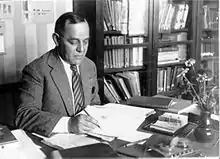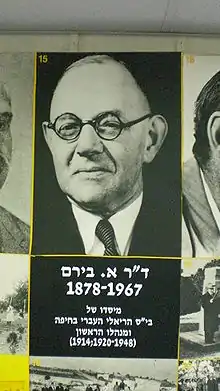Arthur Biram
Arthur Yitzhak Biram (Hebrew: ארתור בירם; August 13, 1878 – June 5, 1967) was an Israeli philosopher, philologist, and educator.


Biography
Biram was born in Bischofswerda in Saxony in 1878, the son of a modest, but successful businessman. Biram attended school in Hirschberg, Silesia. His sister Else Bodenheimer-Biram became a well known art sociologist.
He studied languages, including Arabic, at University of Berlin and at University of Leipzig and earned a doctorate (Dr. phil.) at the University of Leipzig in 1902, discussing the philosophy of Abu-Rasid al-Nisaburi.[1] In 1904 he concluded the rabbi seminar at the Hochschule für die Wissenschaft des Judentums. Afterwards he taught languages and literature at the Berlinisches Gymnasium zum Grauen Kloster.
Biram was one of the founders of the Bar-Kochba club, and a member of the German liberal religious stream 'Ezra', which recognized the importance of high school education. In 1913, he emigrated to Ottoman Palestine.
He married Hannah Tomeshevsky, and they had two sons. Both sons were killed: Aharon died in an accident while on reserve duty, and Binyamin, an engineer at the Dead Sea Works, was killed by a mine.
Pedagogic career
Biram founded the Hebrew Reali School in Haifa in 1913 and was appointed its first principal,[2] but a few months later, World War I broke out, and Biram was drafted by the German army and stationed in Afula. In 1919, he returned to school.
As part of Biram's philosophy of education, in 1937 he implemented compulsory Hagam[3] training for girls in the Hebrew Reali School in Haifa, laying the foundation for recruitment of women in the Haganah, and later the Israel Defense Forces.
In 1948, he resigned his post as principal, and on his 75th birthday, he authored a collection of essays on the Bible. Altogether, he wrote about 50 publications in Hebrew, German, English, and Arabic. Biram died in Haifa in 1967.
Awards and recognition
In 1954, he was awarded the Israel Prize for education.[4]
See also
References
- Die atomistische Substanzenlehre aus dem Buch der Streitfragen zwischen Basrensern und Bagdadensern, Arthur Biram, dissertation
- The Hebrew Reali School in Haifa Archived March 8, 2014, at the Wayback Machine
- Haganah, written by Dganit Boni-Davidi (acronym for Expanded Physical Education)
- "Israel Prize recipients in 1954 (in Hebrew)". Israel Prize Official Site. Archived from the original on February 11, 2010.
Further reading
- Socio-Educational Dilemmas: a typology illustrated by the history of Hebrew education in Haifa during the British Mandate, by Yuval Dror, article in the Journal of Educational Administration and History, 1478-7431, Volume 26, Issue 1, 1994, Pages 35 – 54, doi:10.1080/0022062940260104
- Encyclopedia of Zionism and Israel, by Raphael Patai, Vol. 1, Herzl Press, 1971
- Uwe Fiedler: Er gründete in Haifa eine Schule. BoD – Books on Demand, 2017 (in German)
- [htt== External links ==p://www.jpost.com/Magazine/Features/Article.aspx?id=529 Streetwise: Rehov Biram, Haifa, written by Wendy Blumfeld]
- Publications about resp. by Arthur Biram at Worldcat
- Biography at the Upper Lusatian Science Society (archived, in German)
